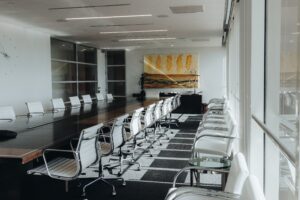Safe breaks: How to protect workers when they’re not working
In today’s fast-paced work environments, the health and wellbeing of employees goes beyond the tasks they perform during their working day. Dakota Murphey explores strategies for the physical safety, comfort and mental health of employees during their ‘at leisure’ time at work.
Whatever workplace they are in, prioritising their safety extends to their breaks and during any time an employee is physically at work. While they may not be sitting at a desk, at their usual work station or actively operating a machine, they still remain under the company’s jurisdiction.
If they are working out in an office gym, taking some time out to meditate or read in a quiet space, an employer must create and sustain a safe company culture.
Understanding the importance of safe breaks
 First of all, it is important to consider why safe breaks are essential in every company and for every employee, irrespective of what job they are doing or the position they hold. Not only is it a legal requirement, but it’s vital for employee wellbeing and corresponding productivity.
First of all, it is important to consider why safe breaks are essential in every company and for every employee, irrespective of what job they are doing or the position they hold. Not only is it a legal requirement, but it’s vital for employee wellbeing and corresponding productivity.
The law states that any employee over the age of 18 is entitled to three types of break – rest breaks at work, rest between working days and rest between working weeks.
Anyone working more than six hours a day has the right to one uninterrupted 20 minute rest break during their working day (taken as a tea or lunch break). Similarly, employees are entitled to 11 hours of rest between working days and a full 24 hours where they do not work each week.
Given that employees spend a significant portion of their time in the workplace, providing safe areas to relax in fosters a positive work environment. Promoting health and safety during breaks can mitigate the risk of accidents or injuries, enhance productivity and cultivate a healthy company culture.
The Government’s Health and Safety at Work Act also issues guidelines on comfort and sanitation of employees in respect of their break times. These apply to fitness equipment, routes in and around work or distinct spaces to ensure they are managed to protect staff from hazards, falling objects, breakages etc.
Whether a member of staff is making a sandwich in your office kitchen, or having a jog on the company’s grounds, appropriate provisions must be made to make sure that the environment they are using is healthy and correctly furnished, well lit and ventilated.
Prioritising wellbeing in non-working spaces

Credit: Unsplash/Max Frajer
Non-working spaces in your company might mean a variety of different rooms and spaces for different purposes that employees are free to use and enjoy during their breaks. They might include cafes or other food preparation areas that must be hygienic or other communal areas with shared equipment.
In the realm of workplace health and safety, businesses tend to focus on activities directly related to work, but it remains equally important to ensure the general wellbeing of employees. This means exploring all the spaces occupied by employees and creating additional areas or zones where staff can relax to recharge their batteries.
Many of today’s modern workplaces are equipped with gym facilities to promote employees’ physical and mental health. Further boosts to wellbeing may be as simple as encouraging staff to take regular or extra breaks to lower stress or burnout, and introduce daily walks outside or desk yoga. If staff remain in working areas beyond work hours, these communal areas could also be adapted to become less formal.
However, if you are refurbishing an office with a games room, knowing where to put a pool table or position the office video gaming station will matter, and being mindful of safety in relation to these features is key. In fact, any sport or leisure equipment set up in your office or work location must be safely installed, and carefully positioned in a location that is deemed acceptable. For instance, a ceiling based launch monitor might work best for indoor simulated gaming equipment while a larger, open-plan area will be perfect for table tennis.
Employers should also be prepared to conduct regular inspections of gym or sport equipment to identify any defects or hazards.
Encouraging office workers to take a safe break
In any office setting with dedicated leisure facilities, employers must provide adequate training on equipment usage and safety protocols. These formal policies will prevent accidents and injuries. Employers should enhance health and safety procedures in all the workplace settings they oversee, educate staff on how to use equipment properly and provide guidance on daily housekeeping, such as always cleaning shared equipment after use, or leaving an area clear and tidy.
The positive benefits of installing gym equipment in your office or work environment are widely reported, but while exercise rooms and equipment can promote physical activity and camaraderie among employees, they do present potential risks. Implementing key safety guidelines will ensure as safe an environment as possible is available for all.
In general, employers should be able to provide leisure time spaces that are clean and free from hazards, with regular maintenance checks in place and swift resolution of any safety concerns. The top priority should be your ability to guarantee a secure environment for employees.
Creating inclusive non-working spaces
Addressing the unique health and safety considerations and remaining aware of safeguarding extends to all non-working spaces on your company’s premises, from kitchens and cafes to prayer rooms, outdoor gardens, toilets and private breastfeeding spaces or quiet areas of contemplation.
 Setting up shared spaces safely within your organisation is paramount. Cafes and lounge areas all require careful attention to safety and, in the case of kitchens, should be fitted with the correct fire prevention advice and safety gear that extends to fire risk reduction across an entire office or workplace.
Setting up shared spaces safely within your organisation is paramount. Cafes and lounge areas all require careful attention to safety and, in the case of kitchens, should be fitted with the correct fire prevention advice and safety gear that extends to fire risk reduction across an entire office or workplace.
Creating the correct spaces for specific needs and prioritising inclusivity is a principle consideration when designing workplace break-from-work facilities. Incorporating the diverse needs of your workforce will allow you to design appropriate safeguarding areas such as multi-faith rooms, wellness areas, exercise zones or nursing rooms.
Ensuring these spaces are all safe and comfortable demonstrates a commitment to comprehensive employee wellbeing.
Multi-faith rooms play a significant role in accommodating diverse religious practices, and ensuring their accessibility and privacy is paramount. Individuals must be able to observe their religious rituals without interruptions or discomfort, while maintaining cultural sensitivity. Similarly, private breastfeeding spaces or quiet areas designated for contemplation serve as sanctuaries for employees seeking moments of solitude.
Privacy is always important, when creating spaces where individuals feel comfortable to engage in personal, contemplative activities, offering a place of tranquillity. Providing amenities like comfortable seating, nursing pillows or meditation cushions further enhances the experience for those using these areas.
Fostering a culture of respect and support emphasises your company’s commitment to accommodating the needs of its entire workforce.
Prioritising employee health and safety extends beyond the confines of traditional work tasks. This should be proactively upheld within various workplace environments, establishing safe breaks and introducing and maintaining spaces that promote employees wellbeing and productivity.
By ensuring such provision, employers not only fulfil their legal obligations but also create a culture of care and support. This investment in employee welfare not only enhances but safeguards the overall health and wellbeing of the workforce, reflecting your commitment to their continued success.
Safe breaks: How to protect workers when they’re not working
Dakota Murphey explores strategies for the physical safety, comfort and mental health of employees during their ‘at leisure’ time at work.
Dakota Murphey
SHP - Health and Safety News, Legislation, PPE, CPD and Resources 
 First of all, it is important to consider why safe breaks are essential in every company and for every employee, irrespective of what job they are doing or the position they hold. Not only is it a legal requirement, but it’s vital for employee wellbeing and corresponding productivity.
First of all, it is important to consider why safe breaks are essential in every company and for every employee, irrespective of what job they are doing or the position they hold. Not only is it a legal requirement, but it’s vital for employee wellbeing and corresponding productivity. 
 Setting up shared spaces safely within your organisation is paramount. Cafes and lounge areas all require careful attention to safety and, in the case of kitchens, should be fitted with the correct fire prevention advice and safety gear that extends to
Setting up shared spaces safely within your organisation is paramount. Cafes and lounge areas all require careful attention to safety and, in the case of kitchens, should be fitted with the correct fire prevention advice and safety gear that extends to